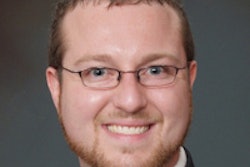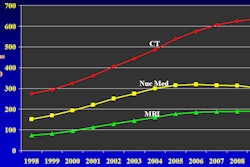CHICAGO - Medicare CT use varies widely depending on geography -- so widely that beneficiaries in the highest utilization state receive 70% more CT scans than those in the lowest state, according to researchers from Philadelphia.
Variations like this imply that imaging is not being used appropriately, the group concluded.
At the RSNA 2011 meeting, Dr. Richard Sharpe from Thomas Jefferson University presented findings from a study that examined geographic variation in CT utilization, a topic that has become increasingly interesting to policymakers concerned about over- or underutilization.
Sharpe's group used data from the Centers for Medicare and Medicaid Services (CMS) Medicare 5% Part B Carrier and Beneficiary files for 2007 to tabulate beneficiaries in each state and to calculate overall utilization rates per 1,000 beneficiaries.
"We found enormous geographic variations in the CT utilization rate," he told AuntMinnie.com. "And that means that some people are being exposed to too much radiation."
Sharpe's team found that the overall CT utilization rate was 595 per 1,000 beneficiaries. Florida, Maryland, Rhode Island, Kentucky, and New Jersey had the highest rates, while New Mexico, South Dakota, Hawaii, Idaho, and Oregon had the lowest rates. The ratio of highest to lowest state CT utilization was almost twofold overall.
Geographic variation in overall CT utilization rates
|
||||||||||||||||||||||||||||
"Almost everyone in Florida is getting CT exams," Sharpe said.
The relative risk of CT utilization by body part imaged (ratio of geographic variation) was as follows:
- Body: 1.8
- Head: 2.0
- Spine: 2.6
- Vascular: 3.4
- Musculoskeletal: 3.6
- Cardiac: 42.2
"The most common procedures, CT body and head, show twofold variation, while spine, vascular, and musculoskeletal CT, which are much less utilized, show threefold variation," Sharpe said. "Only cardiac CT, which has very low utilization and is a newer technique, shows enormous variation."
The findings suggest that the issue of geographic variation in CT use deserves further study to address both over- and underutilization concerns, according to Sharpe.
"The implication of our findings is that if there are such geographic variations in CT use, that means someone is not appropriately using imaging services," Sharpe said. "In some states, patients aren't getting enough CT exams, while in other states, patients are getting too many -- which not only means they're being exposed to excess radiation, but also that the healthcare system is paying an enormous amount of money for procedures that may not have appropriate benefit for patients."



















